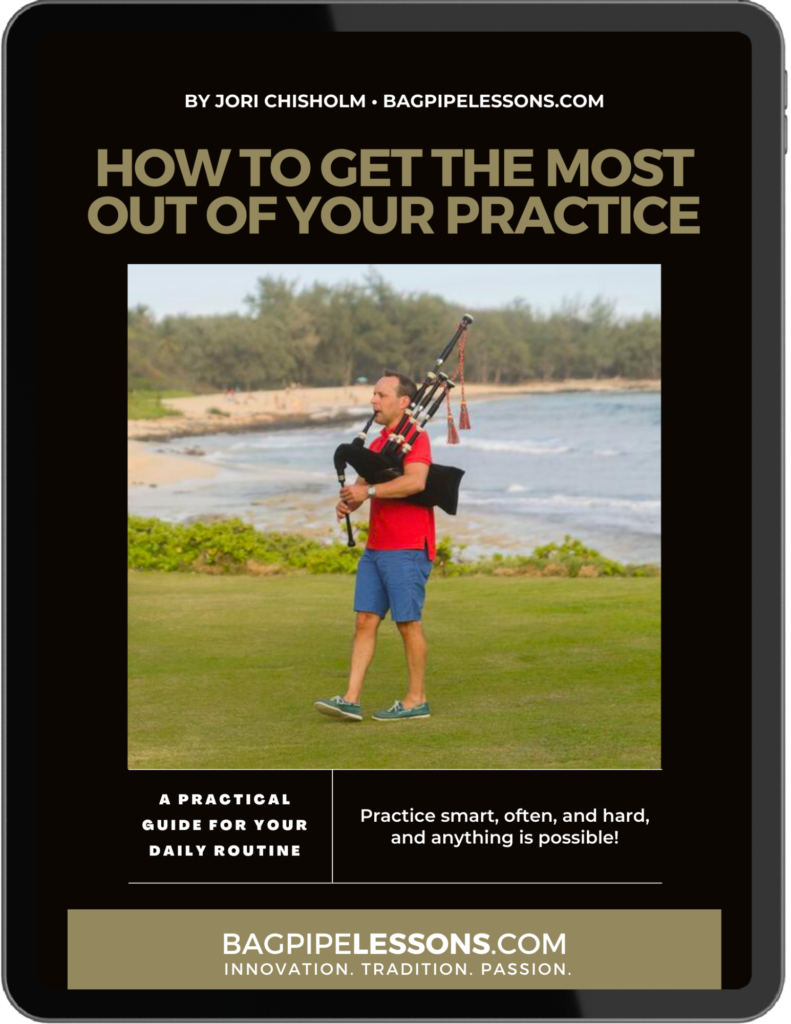
AS FEATURED IN

Transform Your Bagpipe Technique with the Ultimate GDE Gracenote Workout for Bagpipers of All Levels
by Jori Chisholm, Founder of BagpipeLessons.com
Last Updated: April 11, 2025
I’m Jori Chisholm, the founder of BagpipeLessons.com. Join me for a fun and engaging workout on GDEs, the cornerstone gracenote combination in bagpipe music. From jigs and reels to marches and piobaireachd, mastering GDEs is crucial for every piper. In this video, I’m excited to share my ‘Power GDEs’ exercise, a favorite of mine from the exclusive Power Exercises series available at BagpipeLessons.com. This exercise is a game-changer for pipers at all levels, aiming to enhance your fingering technique, ensuring your gracenotes are executed with precision and consistency.
We’ll explore GDEs in various forms, focusing on achieving clarity and consistency. Remember, good form is key: keep your hands relaxed, fingers close to the chanter, and maintain a steady rhythm. Practice with the Piper’s Metronome™, my specially designed app for pipers, to keep your timing precise. Download it for free at PipersMetronome.com and upgrade for more features.
Watch the video and scroll down to read the full video script.
Quick Reference for the GDE Note Combinations Played in this Exercise:
GGG AGG AAA BGG BAA BBB CGG CAA CBB CCC
Video Transcript:
Today I’m going to help you elevate your bagpipe fingering technique with one of my favorite exercises. It will help you with one of the most important gracenote combinations found in virtually every type of bagpipe tune, and that is the GDE. From jigs and reels to strathspey and marches, piobaireachd, and more, GDEs are more than just a combination of gracenotes; they’re the building blocks of your technique. Mastering your GDEs is essential for improving your technique and helps you play cleaner, faster, and with better consistency.
In today’s video, we’re focusing on one of my favorite exercises I call “Power GDEs.” You can download a PDF of this exercise right now from BagpipeLessons.com. A link is also in the description below. It’s designed to help your fingering, so your gracenotes are executed flawlessly, so you can play your tunes with consistency and confidence. It’s part of my series I’ve created that I call the Power Exercises Series, which includes Power Doublings, Power Taorluaths, Power Birls, Power D Throws, and more. All of these exercises are available exclusively to members of my BagpipeLessons.com Inner Circle Membership.
Joining my Inner Circle gives you complete access to all of these exercises and hundreds of lessons, videos, tunes, and exercise, and weekly live classes with me, to help you take your piping to the next level. Whether you are a brand-new piper or have lots of experience, there’s something for you at the Inner Circle. Learn more and join today at BagpipeLessons.com/membership.
The beauty of GDEs lies in their versatility and their role in helping you develop speed and control. The GDE is a foundational element, and mastering the GDE will help you master other embellishments across all of your other tunes. Today’s exercise is all about deliberate practice, aimed at achieving clear, clean, and consistent GDEs. We’ll explore GDEs played on the same note, like low A, low A, low A, and those involving changing notes, like C low A, low A.
When you practice your GDEs, make sure all three gracenotes are identical in size to keep them sounding crisp and clear. Rhythmically, the goal is to space the gracenotes evenly, so the melody notes are of identical length. We’ll go through an exercise that starts with eight reps of each GDE combination, then four, then two, and finally one. This structure allows you to progressively warm up your fingers and master these note combinations, eventually building up speed and fluency.
Here are a few things to keep in mind while playing this exercise: always maintain good form, which means keep your hands loose and light on the chanter. Don’t grip or squeeze. It’s totally natural to tighten up as you focus on clean, consistent fingering, but your goal is to keep your hands relaxed and controlled, never tight. If you find your hands are getting tired or tightening up, take a quick break, something like 20 or 30 seconds, shake out your hands, and then try again. If your fingers won’t do what you want them to do, relax, try again, or take a quick break. Never play tight.
Also, keep your fingers close to the chanter. This helps you play clean and fast. High finger height slows you down. Listen carefully for crossing noises and make sure you’re not cutting the first note, especially in these combinations that are similar to tunes that start with C-A or B-G. Read the music, even if you have the exercise memorized. Keep your eyes on the music and use the practice to help your sight-reading skills. Tap your foot. The key to steady, consistent timing is a steady, confident foot tap. Play slow; keep things slow and controlled. If you feel you can’t keep up or if you feel overwhelmed by the reading or playing of the exercise, slow it down. The secret to playing well at a faster tempo is to play well at a slower tempo first. Get control, and then things will speed up over time.
Use a metronome. The metronome does one thing extremely well: it keeps a steady beat. Use your metronome to keep things rock solid as you develop and refine your own internal sense of beat. I love to practice my exercises with the metronome, which helps me stay controlled and precise with my timing. To get the most out of your limited practice time, you can use your exercises to work on the fingering technique and the timing and the rhythm because that’s the ultimate goal, right? To play clean and controlled and to use your good technique to play music.
The metronome I’m using is the Pipers Metronome. It’s an app I created specifically for pipers and the way we play and practice our tunes. It has tons of fantastic features you won’t find in any other app. You can get it for Apple and Android, and it’s a free download from the app store or from PipersMetronome.com. After trying it out for free, you can upgrade to the full version to unlock all of the cool features.
When you play along with the metronome, try to keep right on the beat, ensuring your notes are steady and even. The unique display of the Pipers Metronome makes it easy to see when you’re right on the beat or slightly ahead or behind. If the tempo of this video doesn’t quite match your current playing speed, you can easily adjust it. YouTube allows you to change the playback speed to suit your comfort level. Just click on the little gear icon in the bottom right corner of the video player and choose playback speed, then select a speed that matches the tempo that works best for you.
It’s completely okay to slow things down initially. Mastery of any musical skill requires patience and development over time, so start at a pace where you feel comfortable and in control, and gradually increase the speed as you gain confidence and skill. This step-by-step approach ensures that you’re not just playing the notes, but mastering them, and mastering the timing as well.
Okay, grab your practice chanter or your pipes, and let’s get started. Here we go.
Great job! If you have any questions or comments, please leave them in the comment section below, or if you have a specific question about a tune or something you’re working on, I would love to hear from you. If you enjoy this exercise and this video, I have many, many more available to members of my BagpipeLessons.com Inner Circle. With your membership, you gain full access to the very best of everything at BagpipeLessons.com. This includes weekly live, interactive online classes for pipers of all skill levels, led by me and World Champion guest instructors. You’ll also get access to my exclusive lesson library, filled with hundreds of videos, lessons, tunes, exercises, demonstrations, and more, covering nearly every topic in piping, from music theory to technique to tuning, maintenance, setup, and so much more. And you get personalized support from me to help you reach your piping goals. To find out more about joining my Inner Circle, please visit BagpipeLessons.com/membership. I would love to see you there.
For more free resources, including videos, lessons, and other guides, make sure to head over to BagpipeLessons.com. Download my free PDF guide called “How to Get the Most Out of Your Practice.” The link is in the description below. Remember to subscribe and click the notification bell to stay updated when we post new videos here on the BagpipeLessons.com YouTube channel. Thanks for watching, and happy piping!





